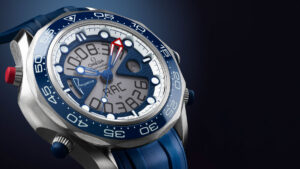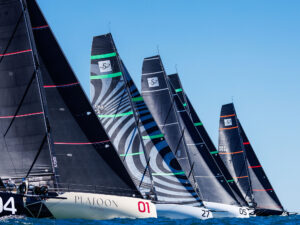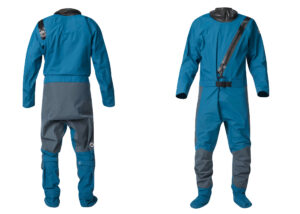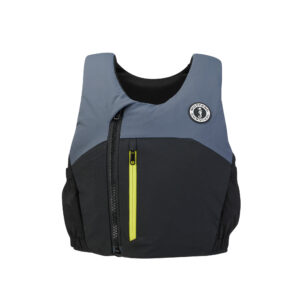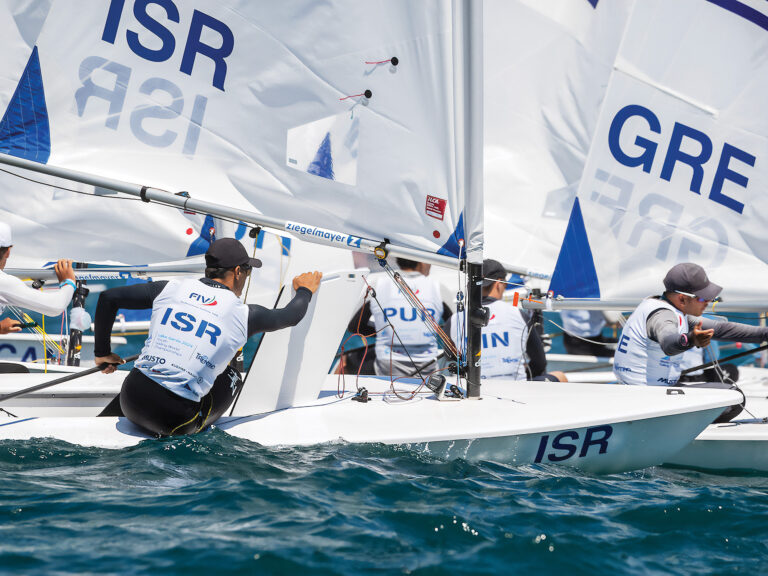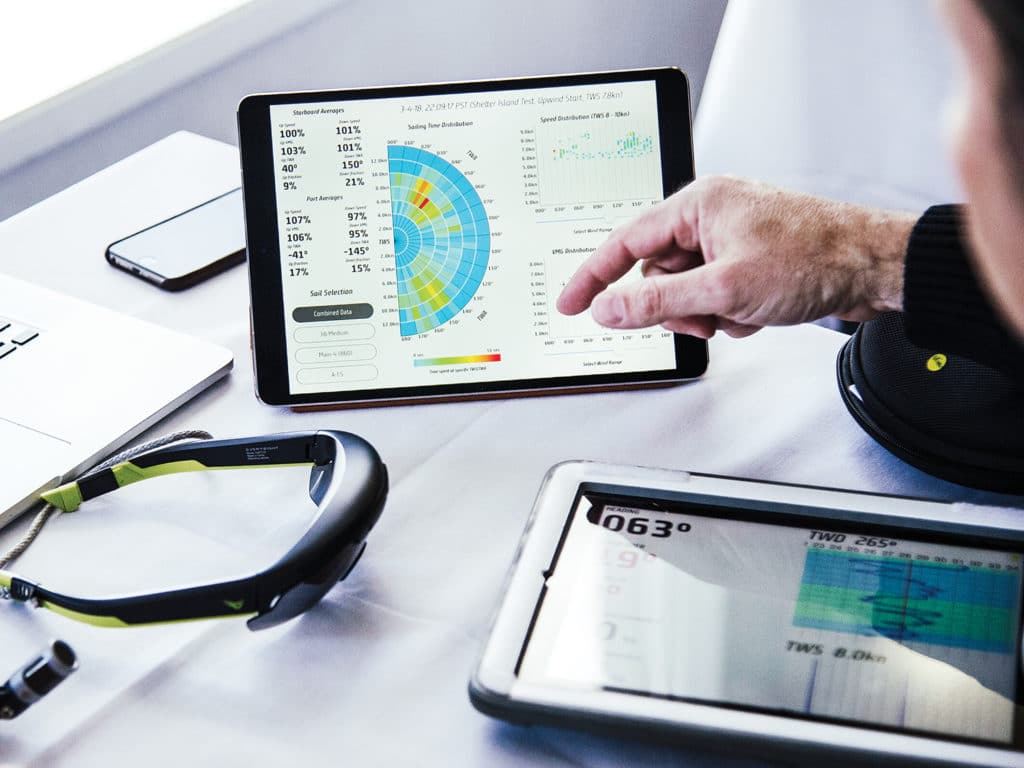
The start line is set, so we ping the ends using the Tactiqs application that’s loaded onto our iPad, simply tapping a button for each line end on the screen. In my line of sight—on the inside surface of the augmented reality sunglasses I’m wearing—the Tactiqs software tells me the pin is favored by 8 degrees. The app uses the boat’s wind instruments to calculate this bias, but if we didn’t have wind instruments, the app would show us a “wind-shot” icon when we go head-to-wind.
As we look up the course, we agree it looks as if there’s more wind on the left side of the course, so we formulate our strategy: start near the pin and go straight. But what if the wind goes right and we get pinned past layline?
No worries: The app’s default data layout displays the last 15 minutes of wind direction and speed, so I have a good idea what might happen.
A swipe backward on the AR glasses’ right temple switches the display to its “wind view” and confirms the wind is oscillating 11 degrees every 6 minutes or so. Observing that the wind is in a slight right phase, I’m confident it won’t go any farther right. In fact, odds are that it goes farther left.
Tactiqs is an iOS-based app for iPhones and iPads that integrates with instrument systems with an NMEA interface to provide the user with data to make better tactical decisions on the water. It’s also useful after racing for race review and learning. The app was developed by Oliver Michaelis and Clement Maestri. For our first trial, we’re using an iPad and an iPhone 7 Plus, synced with the B&G instruments on Michaelis’ Farr 30 in San Diego.
The app uses existing NMEA data from their instruments via Wi-Fi connection. Many types of units already have Wi-Fi capability. If not, a simple lightweight box can add Wi-Fi to the boat’s setup. The system can send to multiple iOS devices, and augmented reality glasses, with individual display configurations, for different locations on the boat.
Like most apps, it takes a little time to learn the functions, swipes and taps, etc. Within 20 minutes, however, I had it figured out and was able to cycle between various types of data. My favorite part was that once I graduated the short intro, Michaelis and Maestri broke out the augmented-reality glasses with the built-in display.
Ten minutes later, I was driving the boat toward the start line while distance-to-the-line and burn time were displayed inside my glasses. I nailed that start perfectly.
Next, the race committee displays its course signals: 1.2 miles to the weather mark, at a bearing of 255 degrees. Course 1 is also displayed. The “course” icon on the app gives direct access to any preconfigured courses and a windward/leeward course wizard. A quick entry of the number of laps, direction and distance to Mark 1, and the course overview on the iPad now shows laylines to the weather mark. Maestri and Michaelis have been very good about recording what sails they use in which wind conditions with the sail-tracking function of Tactiqs, so they know their inventory’s fastest configurations. The boat’s instruments are reading 12 knots and recorded history says we should be using the medium jib. Because I am getting increasingly comfortable with the system, I have no reason not to believe the data.
As the race committee sounds the warning, we ready the timer in the app by swiping up on the iPad screen to switch between performance data and start data. It’s easy to sync and adjust. We can access many other functions on any of the connected iOS devices or directly through the touch interface on the AR glasses. After the warning signal, the iPad displays the starting laylines, time to start, time to the line, and burn time; the AR glasses display the same info in a bird’s eye view.
This could be a real weapon for a driver or tactician. With 25 seconds to start, while reaching away from the line, I can see we are a little above the pin layline with eight seconds to burn.
As we approach the pin layline, we go head to wind to leave ourselves room to bear away later and accelerate while burning up the eight seconds.
Now, with one second to burn and 10 seconds to the start we bear away at the pin and accelerate. Perfect start at the favored end, headed to more pressure. At this point, I’m starting to appreciate the time that Michaelis and Maestri have spent during the past two years testing and refining the user interface on the water. The app gives you all the key controls without using a menu structure, which is simple.
The AR glasses use a forward swipe on the right temple to mark a time or position; a second gesture selects what that moment meant—for example, starting the race timer or pinging the line.
At the five-minute signal, simply swipe forward to get the time, then select “Start Timer” in the glasses’ menu to tell the system what you want it to do. The start timer appears, and it is already adjusted for the delay from the initial swipe. No more hovering over a button to get that right moment!
As we trim the sails on hard and head upwind, the Tactiqs interface is showing 20 degrees of heel, which feels like too much. The Farr 30’s polars, which are easily imported via the Tactiqs web portal, confirm we are a little slow. With the backstay tightened, we flatten the main, tighten the forestay and reduce our heel angle. Now we’re matching our polars.
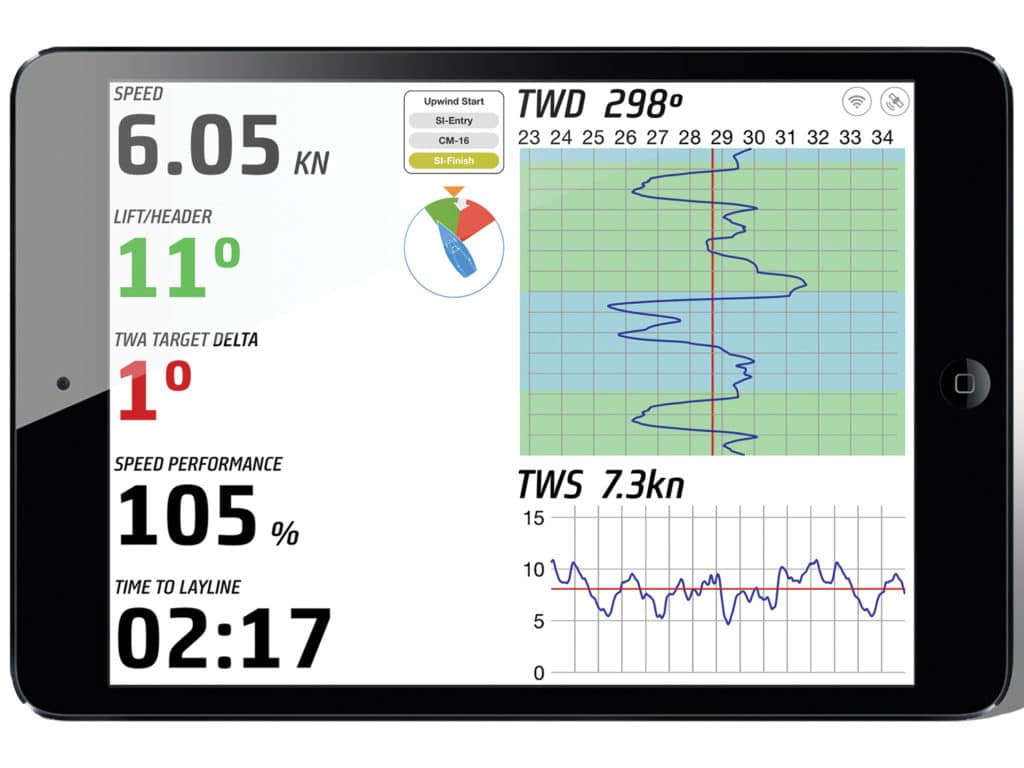
The next hurdle is sailing out to the left side of the racecourse without overstanding the mark or getting tacked on by other boats. Fortunately, the laylines are displayed in my AR glasses in a bird’s eye view—swipe backward to cycle through the different views—as well as on the iPad. The display reads: 1:20 to the port layline, 6:36 to the starboard layline. We tack at 30 seconds to the port layline. This buffer lets us take advantage of a late lefty or someone tacking on us. I swipe my glasses back to the performance view to look at the heel data again.
With the mark at 1.2 miles, it’s difficult to see between the large groundswell running. Luckily, the glasses have a built-in compass function, it displays an arrow pointing to the direction where the mark should be located. As I turn my head toward the mark, it matches and shows me a guidance graph pointing at the mark.
The wind history that we looked at before the start is proving useful as we start seeing a small lift coming into the top mark on port. A glance at the app confirms this. The wind is trending slightly left now. Our lead is increasing. We are just laying the weather mark shaving off valuable time and distance.
With there being more wind on the left side of the course and now a definable left shift, we decide we will set the spinnaker and stay on starboard jibe on the run. As we round the mark, the laylines in my glasses change automatically to the downwind laylines and jibe angles.
I start wondering how can I use the Tactiqs system on a smaller boat without wind instruments. Over time, I could add windspeeds and manually input tack and jibe angles for a specific boat using its VPP targets. The app tracks wind direction based on your point of sail at these target angles.
Without wind data coming from the boat, the system automatically prompts you with input icons that let you set the initial wind direction or point of sail. After setting up the course, you can manually add windspeed, and the system will provide laylines for upwind and down sailing.
As we sail down the run, we get lifted slightly, so we jibe halfway to layline. Our nearest competitor sails behind us and continues out to the left side of the course. We’re happy in a slight header. All is looking good.
Our earlier pings remind us that the pin end is favored and the app reminds us we are nearing layline to the pin.
We jibe and sail the last bit to the finish. Our nearest competitor has made a small gain. Later we will go through the course data and replay the race in fast forward—swiping the left edge of the iPad gives access to the app’s race mode, analytics mode, sail tracker and setup functions. We review the wind-direction data. We find that, after jibing the first time on the run, the wind continued to shift right for another few minutes and the competitor gained leverage to leeward of us in a decent header, effectively sailing less distance.
We also forgot to remember that we’d said there was more pressure on the left side of the course. The moral here is that even with great software, we must look around and make decisions based on what we see.
This is an efficient aid to help make better tactical calls—but it doesn’t make decisions for you.
Michaelis and Maestri are refining the Tactiqs system and adding features. Some of the things coming soon are an Apple Watch add-on, a message system between iOS devices and AR glasses to help the tactician coordinate crew work on bigger boats, and the ability to aggregate data from multiple races into dynamic VPP and sail charts.
For Android users, while the master device must be an iPhone or iPad, Tactiqs offers an Android Smartwatch App (Wear OS) as an add-on. It can: do start screen with timer and line info; start birds-eye view like the glasses; provide a performance screen with three selectable metrics; show a course-data screen with three selectable metrics; provide layline view like the glasses; and serve as a remote control for the race timer and ping functions.

